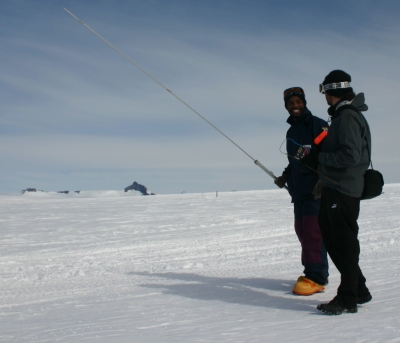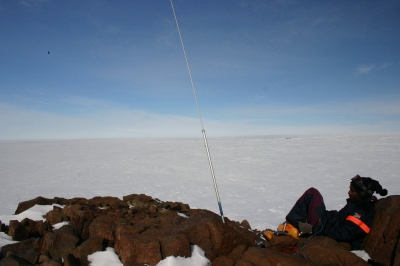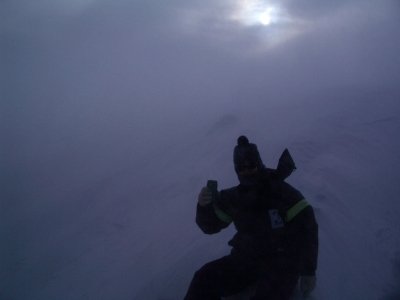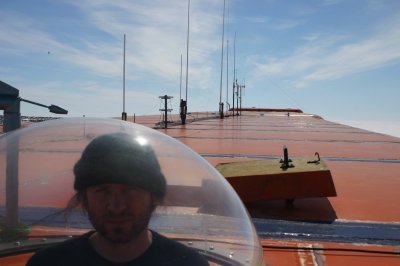I-TASC expedition 2006/2007
Today was a great day. I started off a bit sluggish. Not sure what that was, I got up, did the skivvies (chores) at 7am, drank two hard hitting shots of espresso, and went straight back to sleep.
Then we had an I-TASC meeting to plan the AWS scenarios. Seems that we won’t try any more fiddling with the serial ports on the radio modems, we will instead place a computer at the site of the AWS to manage the data gathering and transportation (via the modems) to SANAE. That may change if we have some advice from the modem manufacturers but until then this is the plan. We also spoke about the gear Marko is bringing. He is in Cape Town right now loading a plane with gear for us. The plane flys to Troll (Norwegian base) and it costs 12 Euro per kilogram to ship material. The chopper pilots from here then fly to Troll to pick it all up. I think Marko has done quite some shopping which is great news. He is also sending material for the radio station to play and some radio receivers for the crew here.
After lunch and the meeting, First Born decided he wanted to shoot a video he has been planning for his forthcoming hiphop album. So Remmy (our roommate) and Danny (one of the chopper crew and also a DJ on the radio station) dressed up in their big winter clothes which kind of looks hiphop in a very sub-zero way. Baggy jackets, snow glasses, big boots. They cruised around with attitude on the skidoos while I buried myself in snow and ice trying to get the right camera angles. It was heaps of fun and I think my days filming the trots for TV ONE left me with a steady hand on the cam (it was a bit more fun filming today than keeping a camera on horses going round and round in circles).
We viewed the results and I was surprised they looked so good, I was sure the white balance would be weird or contrast would be bad as I couldn’t see the LCD screen on the camera due to the glare off the ice and I had to rely on the black and white viewfinder. First Born did a good job with miming his own rhymes and Daniel looked mean (although he could only maintain it for so long before getting self-conscious) and Remmy looked like he had been doing this sort of thing all his life. It was a great couple of hours.

Then it was time to try and get the telephone working with the radio station so people could call in live to the station and be put on air. The head of PWD (the people that maintain the base by contract) was real keen to do a talkback slot and First Born was training him (Kim) today. So thankfully Matthew Biederman (a friend from San Francisco/Montreal) answered my query in a previous diary listing where I asked for ideas on how this could be done. Matthew has such a pragmatic turn of mind and his recommendation was really fascinating. He suggested we make an induction coil that would pick up the electrical current of the speaker in the phone’s handset and then plug this into the mixing desk. Sounded crazy to me but Matthew does have a tendency to get things right, so we found a ferrite core from an old power transformer at the base and ripped it out of the old casing.

We then found some about-to-be-thrown-away copper coated wire and wound it around the core 100 times.

Then the two ends of the wire were soldered onto an audio jack. We then opened the handset of the telephone and threaded one of the wires going to the speaker through the middle of the core.

We plugged in the cable to the audio desk for the station – and what do ya know… .talkback radio!
Matthew, I owe ya _another_ one 😉
So First Born trained Kim and Kim is super excited about doing his first talkback show. … in case you are wondering the calls would be entirely from within the base as each room has a telephone.
Lastly, I got an email today from Julien Ottavi from APO33. It looks like he is keen to help with the DJ Cron script I mentioned a few days ago so we can schedule the station over the net on a 1K connection. This means people in South Africa could control what plays on the radio here even though the connection is a miserly 1K. It would be a wonderful thing to try, and even more wonderful if it works well as there are many scenarios where low bandwidth scheduling could be extremely useful. So, fingers crossed!
Also, a big thanks to Borja Jelic for all his advice on how to set up the AWS computer.
Comment
Hey Adam, was just reading your Antarctic diaries. Wow what an incredible thing to be doing. I was taken with your questioning of the whole enterprise of 'art' in such a space, and the potential imposition of a 'minimal object' / monolith on Antarctic space. I'm curious enough to write and take up some of your valuable email space, I'd love to hear more on how this is being resolved for all of you there.... I'm only asking because I have been following a rather odd tangent over the past few weeks that connects Kubrick, 2001:a space odyssey with minimalism - in terms of the monolith being simultaneously inhuman and human; and the imposition of human scale onto objects which may seem impenetrable. And I was thinking about et al's monoliths which crop up on top of Google earth maps in her last installation in Christchurch. And there you are in Antarctica, with another minimal monolith... Edward Strickland writes about 2001 saying "the nonhuman arrived in utterly nonhuman form: black monoliths ten feet tall ... it was the invasion of the minimal sculptures." But also the minimal sculpture was thought of as site-specific and it seems yours is more navigational - a tool rather than an object - so maybe yours is not an invasion, and maybe it is the opposite, actually a way of stating the inhuman in such a wonderfully alive space. I really enjoyed all your descriptions of the flying ice and snow. sorry there isn't really a question here , but I guess it fits as a comment. I'd love to see an image of your minimal object... cheers and warm regards su



